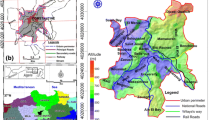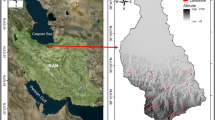Abstract
In this article, the results of a study aimed to assess the landslide susceptibility in the Calaggio Torrent basin (Campanian Apennines, southern Italy) are presented. The landslide susceptibility has been assessed using two bivariate-statistics-based methods in a GIS environment. In the first method, widely used in the existing literature, weighting values (Wi) have been calculated for each class of the selected causal factors (lithology, land-use, slope angle and aspect) taking into account the landslide density (detachment zones + landslide body) within each class. In the second method, which is a modification of the first method, only the landslide detachment zone (LDZ) density has been taken into account to calculate the weighting values. This latter method is probably characterized by a major geomorphological coherence. In fact, differently from the landslide bodies, LDZ must necessarily occur in geoenvironmental classes prone to failure. Thus, the calculated Wi seem to be more reliable in estimating the propensity of a given class to generate failure. The thematic maps have been reclassified on the basis of the calculated Wi and then overlaid, with the purpose to produce landslide susceptibility maps. The used methods converge both in indicating that most part of the study area is characterized by a high–very high landslide susceptibility and in the location and extent of the low-susceptible areas. However, an increase of both the high–very high and moderate–high susceptible areas occurs in using the second method. Both the produced susceptibility maps have been compared with the geomorphological map, highlighting an excellent coherence which is higher using method-2. In both methods, the percentage of each susceptibility class affected by landslides increases with the degree of susceptibility, as expected. However, the percentage at issue in the lowest susceptibility class obtained using method-2, even if low, is higher than that obtained using method-1. This suggests that method-2, notwithstanding its major geomorphological coherence, probably still needs further refinements.









Similar content being viewed by others
References
Acharya G, De Smedt F, Long NT (2006) Assessing landslide hazard in GIS: a case study from Rasuwa, Nepal. Bull Eng Geol Env 65:99–107
Aleotti P, Chowdhury R (1999) Landslide hazard assessment: summary, review and new perspectives. Bull Eng Geol Env 58(1):21–44
APAT Agenzia per la Protezione dell’Ambiente e per i servizi Tecnici (2005) La realizzazione in Italia del progetto europeo Corine Land Cover 2000. http://www.apat.gov.it
Ayalew L, Yamagishi H (2005) The application of GIS-based logistic regression for landslide susceptibility mapping in the Kakuda-Yahiko Mountains, Central Japan. Geomorphology 65:15–31
Ayalew L, Yamagishi H, Marui H, Kanno T (2005) Landslides in Sado Island of Japan: Part II. GIS-based susceptibility mapping with comparison of results from two methods and verifications. Eng Geol 81:432–445
Ayenew T, Barbieri G (2005) Inventory of landslides and susceptibility mapping in the Dessie area, northern Ethiopia. Eng Geol 77:1–15
Berardi R, Petrungaro C, Zonetti L, Magri L, Mucciarelli M (1993) Mappe di sismicità per l’area italiana. ISMES-ENEL, pp 51
Carrara A, Cardinali M, Detti R, Guzzetti F, Pasqui V, Reichenbach P (1990) Geographical information systems and multivariate models in landslide hazard evaluation. In: Proceedings of the 6th international conference field workshop on landslides, Switzerland-Austria-Italy, Aug 31st–Sept 12th 1990, 1:17–28
Carrara A, Cardinali M, Guzzetti F, Reichenbach P (1995) GIS technology in mapping landslide hazard. In: Carrara A, Guzzetti F (eds) Geographical information systems in assessing natural hazards. Kluwer, Dordrecht, pp 135–175
Çevik E, Topal T (2003) GIS-based landslide susceptibility mapping for a problematic segment of the natural gas pipeline, Hendek (Turkey). Environ Geol 44:949–962
Clerici A, Perego S, Tellini C, Vescovi P (2006) A GIS-based automated procedure for landslide susceptibility mapping by the Conditional Analysis method: the Baganza valley case study (Italian Northern Apennines). Environ Geol 50:941–961
Corominas J, Copons R, Vilaplana JM, Altimir J, Amigò J (2003) Integrated landslide susceptibility analysis and hazard assessment in the Principality of Andorra. Nat Hazards 30:421–435
Cotecchia V, Del Prete M (1984) The reactivation of large flows in the parts of the Southern Italy affected by the earthquake of November 1980, with reference to the evolutive mechanisms. Proceedings of the international symposium on landslides, Toronto, Canada 2:33–38
Crescenti U, Dramis F, Gentili B, Praturlon A (1984) The Bisaccia landslides: a case of deep-seated gravitational movement reactivated by earthquake. Comunications du colloque “Mouvements de terrains”. Documents du BRGM, Caen, France 83:15–21
Cruden DM, Hu ZQ (2000) Landslides modes in the Canadian Rockies. Proceedings of the 8th international symposium on landslides, June 2000, Cardiff, Wales, 1st Thomas Telford, pp 359–364
Cruden DM, Varnes DJ (1996) Landslide types and processes. In: Turner K, Schuster RL (eds) Landslides: investigation and mitigation. Transportation Research Board, National Research Council, Special Report No. 247, National Academy Press, Washington, D.C., pp 36–75
Dai FC, Lee CF, Li J, Xu ZW (2001) Assessment of landslide susceptibility on the natural terrain of Lantau Island, Hong Kong. Environ Geol 40:381–391
Ercanoglu M, Gokceoglu C, van Asch Th WJ (2004) Landslide susceptibility zoning north of Yenice (NW Turkey) by multivariate statistical techniques. Nat Hazards 32:1–23
Ermini L, Catani F, Casagli N (2005) Artificial Neural Networks applied to landslide susceptibility assessment. Geomorphology 66:327–343
Fiorillo F (2004) Blue clay slope angle in relation to some geological and geotechnical characteristics, Italy. Q J Eng Geol Hydrogeol 49–59
Fiorillo F, Simeone V (2004) Analysis of rainfall in landslide activation during January-February 2003 in the Central-South-Eastern Italy. In: Morell M (ed) Proceedings of the BALWOIS international conference on water observation and information systems for decision support, Ohrid, Republic of Macedonia, May 25–29, 2004. http://www.balwois.net
Fiorillo F, Parise M, Wasowski J (1996) Slope instability in the Bisaccia area (Southern Apennines, Italy). In: Senneset K (ed) Proceedings of the 7th international symposium on landslides, Trondheim, Norway, 17–21 June 1996, pp 965–970
Gasparini C, Iannaccone G, Scarpa R (1985) Fault-plane solutions and seismicity of the Italian pensinsula. Tectonophysics 117:59–78
Guzzetti F, Carrara A, Cardinali M, Reichenbach P (1999) Landslide hazard evaluation: a review of current techniques and their application in a multi-scale study, Central Italy. Geomorphology 31:181–216
Guzzetti F, Reichenbach P, Cardinali M, Galli M, Ardizzone F (2005) Landslide hazard assessment in the Staffora basin, northern Italian Apennines. Geomorphology 72:272–299
Guzzetti F, Reichenbach P, Ardizzone F, Cardinali M, Galli M (2006) Estimating the quality of landslide susceptibility models. Geomorphology 81:166–184
Jacobacci A, Martelli G (1967) Note illustrative della Carta Geologica d’Italia alla scala 1:100000, Foglio 174 “Ariano Irpino”. Serv. Geol. It., Roma, pp 65
Komac M (2006) A landslide susceptibility model using the Analytical Hierarchy Process method and multivariate statistics in perialpine Slovenia. Geomorphology 74:17–28
Lee S, Ryu JH, Lee MJ, Won JS (2003) Use of an artificial neural network for analysis of the susceptibility to landslides at Boun, Korea. Environ Geol 44:820–833
Lee S, Ryu JH, Lee MJ, Won JS (2006) The application of artificial neural networks to landslide susceptibility mapping at Janghung, Korea. Mat Geol 38(2):199–220
Lee S, Sambath T (2006) Landslide susceptibility mapping in the Damrei Romel area, Cambodia using frequency ratio and logistic regression models. Environ Geol 50:847–855
Leroi E (1996) Landslide hazard-risk maps at different scales: objectives, tools and developments. In: Senneset K (ed) Proceedings of the 7th international symposium on landslides. Trondheim, Norway, 1:35–52
Marinos P, Hoek E (2000) GSI—A geologically friendly tool for rock mass strength estimation. Proceedings of the GeoEng2000 conference, Melbourne, Australia, pp 1422–1442
Moreiras SM (2005) Landslide susceptibility zonation in the Rio Mendoza Valley, Argentina. Geomorphology 66:345–357
Nagarajan R, Roy A, Vinod Kumar R, Mukherjee A, Khire MV (2000) Landslide hazard susceptibility mapping based on terrain and climatic factors for tropical monsoon regions. Bull Eng Geol Env 58:275–287
Pachauri AK, Pant M (1992) Landslide hazard mapping based on geological attributes. Eng Geol 32:81–100
Rautela P, Lakhera RC (2000) Landslide risk analysis between Giri and Ton Rivers in Himalaya (India). Int J Appl Earth Observ Geoinform 2:153–160
Regione Campania (2007) Bollettino ufficiale della Regione Campania, numero speciale del 12 luglio 2007. http://www.sito.regione.campania.it
Schulz WH (2007) Landslide susceptibility revealed by LIDAR imagery and historical records, Seattle, Washinghton. Eng Geol 89:67–87
Skempton AW, Hutchinson JN (1969) Stability of natural slopes. Proceedings of the 7th international conference on soil mechanics and foundation engineering, Mexico City, State of the art volume, pp 291–340
Soeters R, van Westen CJ (1996) Slope instability recognition analysis and zonation. In: Turner KT, Schuster RL (eds) Landslides: investigation and mitigation. Transportation Research Board, National Research Council, Special Report No. 247, Washington D.C., 129–177
Süzen ML, Doyuran V (2003) A comparison of the GIS based landslide susceptibility assessment methods: multivariate versus bivariate. Environ Geol 45:665–679
Süzen ML, Doyuran V (2004) Data driven bivariate landslide susceptibility assessment using geographical information systems: a method and application to Asarsuyu catchment, Turkey. Eng Geol 71:303–321
Tarantino C, Blonda P, Pasquariello G (2007) Remote sensed data for automatic detection of land-use changes due to human activity in support to landslide studies. Nat Hazards 41:245–267
Tasser E, Mader M, Tappeiner U (2003) Effects of land use in alpine grassland on the probability of landslides. Basic Appl Ecol 4:271–280
Tropeano D, Turconi L (2004) Using historical documents for landslides, debris flows and stream flood preventions. Applications in Northern Italy. Nat Hazards 31:663–679
Uromeihy A, Mahdavifar MR (2000) Landslide hazard zonation of the Khorshostam area, Iran. Bull Eng Geol Env 58:207–213
Van Beek LPH, Van Asch Th WJ (2004) Regional assessment of the effects of land-use change on landslide hazard by means of physically based modelling. Nat Hazards 31:289–304
van Westen CJ (1993) Application of geographic information systems to landslide hazard zonation. ITC publication No. 15, International institute for aerospace and earth res. surv., Enschede, The Netherlands, pp 245
van Westen CJ (1997) Statistical landslide hazard analysis. ILWIS 2.1 for Windows application guide. ITC publication, Enschede, The Netherlands, pp 73–84
van Westen CJ, Rengers N, Soeters R (2003) Use of geomorphological information in indirect landslide susceptibility assessment. Nat Hazards 30:399–413
Wang HB, Sassa K (2005) Comparative evaluation of landslide susceptibility in Minamata area, Japan. Environ Geol 47:956–966
Wasowski J (1998) Understanding rainfall-landslide relationships in man-modified environments: a case history from Caramanico Terme, Italy. Environ Geol 35:197–209
Wieczorek GF, Mandrone G, De Colla L (1997) The influence of hill slope shape on debris-flow initiation. In: Chen CL (eds) Debris flow hazard mitigation: mechanics, prediction, and assessment. American Society of Civil Engineers, New York, pp 21–31
Yalcin A (2008) GIS-based landslide susceptibility mapping using analytical hierarchy process and bivariate statistics in Ardesen (Turkey): comparison of results and confirmations. Catena 72:1–12
Yalcin A, Bulut F (2007) Landslide susceptibility mapping using GIS and digital photogrammetric techniques: a case study from Ardesen (NE-Turkey). Nat Hazards 41:201–226
Yee CS, Harr DR (1977) Influence of soil aggregation on slope stability in the Oregon Coast Ranges. Environ Geol 1:367–377
Yin KJ, Yan TZ (1988) Statistical prediction model for slope instability of metamorphosed rocks. Proceedings of the 5th international symposium on landslides, Lausanne, Switzerland 2:1269–1272
Acknowledgements
The authors are grateful to two anonymous reviewers for their accurate revisions, which greatly improved the quality of the manuscript. The authors also wish to thank Dr. Francesco Fiorillo (University of Sannio, Benevento) for his helpful suggestions.
Author information
Authors and Affiliations
Corresponding author
Rights and permissions
About this article
Cite this article
Magliulo, P., Di Lisio, A., Russo, F. et al. Geomorphology and landslide susceptibility assessment using GIS and bivariate statistics: a case study in southern Italy. Nat Hazards 47, 411–435 (2008). https://doi.org/10.1007/s11069-008-9230-x
Received:
Accepted:
Published:
Issue Date:
DOI: https://doi.org/10.1007/s11069-008-9230-x




